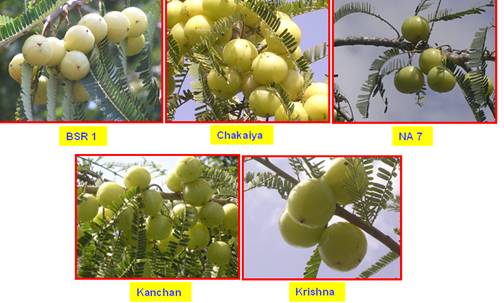 |
| Amla Fruit |
Cultivation methods:
Soil and climate:
Good fertile and loamy soil is suitable for cultivation. Sandy soils also recommended. Water logged conditions not suitable .There are some good hybrid varieties such as Banarasi, Chakaiya, Kanchan, Krishna, NA6. Black and red soils also suitable for cultivation. The tree can grown in dry regions also.
Land preparation:
Early period of monsoon is good time of planting. During May to june is best time for land preparations. First the field should be well ploughed and levelled. With the distance of 7-10m distance of pit digged with the depth of 1 cubic meter. Pit was exposed to sunlight for 20 days, then filled with 15 kg of FYM(farm yard manure) .
Planting:
The common method of propagation is shield budding. Through seeds also it can be raised. From good and old age plants the fruits collected and raised in nursery. But for commercial cultivation budding is the good method. Proper selection of mother plants is necessary for commercial planting. Superior plants need for selections. Bud should be taken from the branch with more female flowers. The healthy budded plants planting in the pits during the rainy seasons or early monsoon seasons. In dried areas the budded plants raised in the nurseries for better results. Nearly 80 seedlings need per one acre.
After Care:
Proper weeding is necessary in early stages. For first two years field should be clean. Correct plant protection measures have to be taken. Pruning is essential for good yield. Leaving 4-5 healthy well shaped wide branches and removing all other weak branches. If we want means we will go with intercrops like pulses. During early stages the crop needs frequent irrigations. After two years once in 15 days only needs irrigation. After 4 years once in 20 days enough to irrigate.
 | |
| Traditional Amla Plant |
Harvest and yield:
The plant starts yielding after 4-5 years of planting. A mature plant gives (10yr old) around 60-70 kg fruit per year. Per kg contains 15-20 fruits. A well maintained tree gives yield up to around 70 years. Average fruit yield is 200kg per year in a good grafted fully mature tree. It costs around Rs 6 per kg. For major medicinal crops banks including NABARD arranging loans for cost of cultivation to farmers. So all farmers will use this oppurtunity and get better returns. Because present production level in India is too low compared to the population. Now we are producing only 2 lakhs tonnes/year only. By creating awareness among people about the health benefits of Amla, We can attain great demand. That time we needs daily 2 lakhs tonnes of fruits.

Pls provide details of the association
ReplyDeleteChhattisgarh Election Result 2018 LIVE: BJP leading in 12 seats, Congress in 5.
ReplyDeleteCapitalstars
Hey Nice Blog!!! Thank you for sharing information. Wonderful blog & good post more relative Best Plant Supplier
ReplyDeleteThanks to share this post.triphala fruit powder is a very good product.
ReplyDeleteThanks to the enthusiastic sharing of bloggers, we are a supplier of plant extracts, and we have more common hobbies for plants.
ReplyDelete